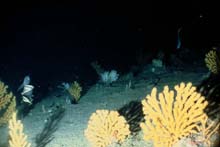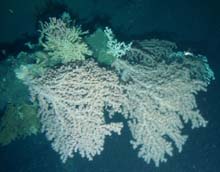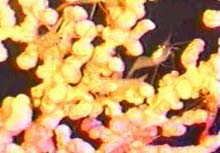
A widely distributed aggregation of Paramurecia on a mud draped rock outcrop in Oceanographer Canyon at 865 m. Photo: Barbara Hecker. Click on image for a larger view.
Deep Sea Corals
Dr. Les Watling
University of Maine
To most people, the concept of a deep water coral is an oxymoron. In fact, until recent legislation banning trawling in deep coral beds off the coast of Norway was promulgated, only a handful of scientists and fishers knew of these species. In fact, in North America, the general public and the broader scientific community know little of their existence. A recent symposium (First International Deep-Sea Coral Symposium, Halifax, July 31 - Aug. 3, 2000) examining deep coral reefs was held to educate scientists about the topic.
Deep water corals have not gone unnoticed by fishers who have complained for at least two centuries of their long-lines getting tangled in the coral thickets. An early account given by Edward Forbes in his 1859 book, Natural History of the European Seas, describes a deep sea coral:
"The great tree Alcyonium (now Paragorgia), a branched zoophyte of leathery texture, is a very wonderful and characteristic production of the abysses of the Boreal Seas. The lines of the fishermen, when fishing for the redfish, or uër, become entangled in its branches, and draw up fragments of considerable dimensions, so large, indeed, that the people of the country believe it to grow to the size of forest-trees, an exaggeration in all probability, but nevertheless one founded in unusual magnitude" (p.71).
Deep water corals likely were abundant in those days, or at least sufficiently abundant to be the predominant creatures brought up from considerable depths. In Forbes’ book, he names the deepest zone of life in the sea after these deep-dwelling corals:

A small isolated "thicket" of Paragorgia on a projecting outcrop (surrounded by mud) in Lydonia Canyon at 1043 m, taken during an Alvin dive in 1980. Photo: Barbara Hecker. Click on image for a larger view.
"Last and lowest of our regions of submarine existence is that of deep sea corals, so named on account of the great stony zoophytes characteristic of it in the oceanic seas of Europe"
(p. 26).
Types and Distribution
Documentation of the distribution of deep water corals has advanced considerably in Europe, with more than 10 commonly-found species identified. Two of the most important, from both general biological as well as ecological perspectives, are the gorgonian (Paragorgia arborea) and the scleractinian (Lophelia pertusa). The latter forms very large reefs in deep water along the Norwegian and Gulf of Mexico coasts and has been the subject of much research in recent years.
Deep water corals, like those that grow in shallow water, can be of two basic types: 1) the hard or stony corals which are related to those found on tropical coral reefs; and 2) the soft corals which include the familiar gorgonians of tropical shallow seas, as well as a broad diversity of other fleshy or tree-like forms. Most of the stony corals found along the U.S. northeastern coast are small, but they can grow to be very massive. The soft corals may be small and delicate or very large and tree-like. The largest of the gorgonians is Paragorgia arborea, which may grow to more than 3 m high.

Shrimp using deep-sea corals as habitat. Photo: Richard A. Cooper. Click on image for a larger view.
Conservation
Corals living in deep water are of interest to conservation biologists because of their great age and the habitats that they represent. Almost all aged corals are well over a hundred years old. Many are about 400 years old, and one, the soft coral Gersmia, was estimated to be more than 1,800 years old. In Norway, some reefs of the stony coral, Lophelia pertusa, are thought to have existed for more than 2,000 years. Because the exact distribution of deep water corals still is not known, they continue to be brought to the surface by people fishing with either long lines or trawls, and by groundfish survey trawls conducted by government fisheries organizations.
Our leg of the "Deep East" project aims to discover areas where deep water corals are abundant and to learn as much about their biology as we can. We will be surveying canyon walls and seamount rims for coral populations. When we find corals, we will photograph and videotape them in their setting as well as up close. We will collect small branch pieces for tissue and genetic analysis, and we will collect and identify animals living with the corals.
Sign up for the Ocean Explorer E-mail Update List.
































